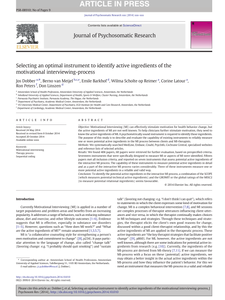The last decade has seen an increasing demand from the industrial field of computerized visual inspection. Applications rapidly become more complex and often with more demanding real time constraints. However, from 2004 onwards the clock frequency of CPUs has not increased significantly. Computer Vision applications have an increasing demand for more processing power but are limited by the performance capabilities of sequential processor architectures. The only way to get more performance using commodity hardware, like multi-core processors and graphics cards, is to go for parallel programming. This article focuses on the practical question: How can the processing time for vision algorithms be improved, by parallelization, in an economical way and execute them on multiple platforms?
DOCUMENT

Motivational Interviewing (MI) can effectively stimulate motivation for health behavior change, but the active ingredients of MI are not well known. To help clinicians further stimulate motivation, they need to know the active ingredients of MI. A psychometrically sound instrument is required to identify those ingredients. The purpose of this study is to describe and evaluate the capability of existing instruments to reliably measure one or more potential active ingredients in the MI process between clients and MI-therapists.
MULTIFILE

Background: For patients with coronary artery disease (CAD), smoking is an important risk factor for the recurrence of a cardiovascular event. Motivational interviewing (MI) may increase the motivation of the smokers to stop smoking. Data on MI for smoking cessation in patients with CAD are limited, and the active ingredients and working mechanisms of MI in smoking cessation are largely unknown. Therefore, this study was designed to explore active ingredients and working mechanisms of MI for smoking cessation in smokers with CAD, shortly after a cardiovascular event. Methods: We conducted a qualitative multiple case study of 24 patients with CAD who participated in a randomized trial on lifestyle change. One hundred and nine audio-recorded MI sessions were coded with a combination of the sequential code for observing process exchanges (SCOPE) and the motivational interviewing skill code (MISC). The analysis of the cases consisted of three phases: single case analysis, cross-case analysis, and cross-case synthesis. In a quantitative sequential analysis, we calculated the transition probabilities between the use of MI techniques by the coaches and the subsequent patient statements concerning smoking cessation. Results: In 12 cases, we observed ingredients that appeared to activate the mechanisms of change. Active ingredients were compositions of behaviors of the coaches (e.g., supporting self-efficacy and supporting autonomy) and patient reactions (e.g., in-depth self-exploration and change talk), interacting over large parts of an MI session. The composition of active ingredients differed among cases, as the patient process and the MI-coaching strategy differed. Particularly, change talk and self-efficacy appeared to stimulate the mechanisms of change “arguing oneself into change” and “increasing self-efficacy/confidence.”
DOCUMENT
